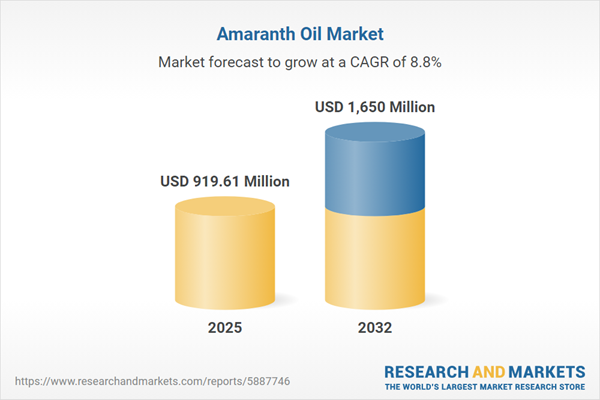Speak directly to the analyst to clarify any post sales queries you may have.
The amaranth oil market is evolving fast as senior executives navigate growing calls for transparency, regulatory compliance, and strategic supplier engagement. Decision-makers face a landscape rich with opportunities for operational enhancement and strengthened market positioning.
Amaranth Oil Market Snapshot
The global amaranth oil market is projected to grow from USD 844.57 million in 2024 to USD 919.61 million in 2025, reaching an estimated USD 1.65 billion by 2032. This expansion reflects a CAGR of 8.77%. Market momentum is shaped by rising demand from cosmetics, functional food, nutraceutical, and pharmaceutical industries. High-integrity extraction technologies now play an essential role in driving product consistency and advancing sustainability across global supply chains. Transparency in procurement and collaborative supplier relationships, rooted in traceable sourcing, are central to meeting stakeholder expectations and fostering commercial trust.
Scope & Segmentation of the Amaranth Oil Market
- Applications: Bioactive properties are supporting innovations in clean-label food, nutraceutical, and pharmaceutical applications, responding directly to global health and wellness trends.
- Product Form: Both refined and unrefined oils, as well as specialty blends, offer manufacturers flexibility in developing tailored ingredient strategies for diverse natural and functional products.
- Distribution Channels: Businesses benefit from multiple channels including direct sales, distributors, supermarkets, hypermarkets, e-commerce platforms, and specialty retailers, allowing broad access across end-user segments.
- Source: Extraction from Amaranthus species such as Caudatus, Cruentus, and Hypochondriacus delivers adaptable sourcing options, with customization possible for specific fatty acid profiles suited to distinct industrial demands.
- Region: The market encompasses the Americas, Europe, Middle East, Africa, and Asia-Pacific. Each region offers unique regulatory and agricultural dynamics, leading to regionally tailored supply chain and procurement strategies.
- Key Companies: Industry leaders—Connoils India Private Limited, Hunan Anbang Pharmaceutical, Brothers Energy Ingredients, Sabinsa Corporation, Akay Natural Ingredients, Naturalin Bio-Resources, Planeteers (UK), BioHarvest Biotech, NOREVO GmbH, and Ruiteng (Beijing) Biotechnology—are advancing extraction technologies and sustainability practices throughout the value chain.
Modern processing, including supercritical CO₂ extraction, preserves key bioactive components while supporting environmental objectives. The diversity among amaranth species enables robust sourcing solutions, and integrated multi-channel distribution approaches create fresh avenues in highly regulated business spheres.
Key Takeaways for Senior Decision-Makers
- Invest in advanced extraction methods to align operations with sustainability goals and enable clear product differentiation in complex markets.
- Develop supplier networks emphasizing traceability and compliance, providing strengthened transparency and responsiveness in global procurement.
- Engage with innovation partners in industry and technology to increase agility, maintaining capacity to adjust quickly to regulatory and market shifts.
- Select between refined and unrefined product variants to match evolving customer requirements, focusing on ingredient quality and natural profiles.
- Enhance regional crop management and adapt sourcing protocols to deepen supplier ties and bolster long-term procurement stability.
- Apply rigorous quality and compliance controls for greater supply chain resilience as procurement criteria and standards become more stringent.
Tariff Impact and Supply Chain Response
Recent adjustments in United States tariff regulations are shaping amaranth oil supply flows. To maintain supply continuity, market leaders are reinforcing supplier connections across Latin America and Asia-Pacific, managing potential disruptions and mitigating risks arising from changes in global trade policy.
Methodology & Data Sources
This research report draws on secondary market analysis, regulatory reviews, and direct interviews with industry professionals. Targeted surveys and expert consultations were used to validate findings, ensuring decision-makers receive relevant, reliable insights for amaranth oil sector strategies.
Why This Amaranth Oil Market Report Matters
- Executives in procurement and operations can access actionable guidance for regulatory compliance, resilient supply chain management, and sustainable sourcing protocols.
- Early identification of new business opportunities enables informed responses to both established and emerging market segments for effective growth.
- The report offers robust benchmarks and frameworks for developing regionally specific strategies aligned with evolving industry dynamics.
Conclusion
By leveraging adaptive sourcing, strong supplier networks, and proactive compliance frameworks, industry leaders can secure lasting value. Agile strategies and comprehensive transparency are vital for successfully managing ongoing change in the amaranth oil market.
Additional Product Information:
- Purchase of this report includes 1 year online access with quarterly updates.
- This report can be updated on request. Please contact our Customer Experience team using the Ask a Question widget on our website.
Table of Contents
3. Executive Summary
4. Market Overview
7. Cumulative Impact of Artificial Intelligence 2025
Companies Mentioned
The companies profiled in this Amaranth Oil market report include:- Connoils India Private Limited
- Hunan Anbang Pharmaceutical Co., Ltd.
- Brothers Energy Ingredients Private Limited
- Sabinsa Corporation
- Akay Natural Ingredients (P) Limited
- Naturalin Bio-Resources Co., Ltd.
- Planeteers (UK) Limited
- BioHarvest Biotech LLC
- NOREVO GmbH
- Ruiteng (Beijing) Biotechnology Co., Ltd.
Table Information
| Report Attribute | Details |
|---|---|
| No. of Pages | 186 |
| Published | November 2025 |
| Forecast Period | 2025 - 2032 |
| Estimated Market Value ( USD | $ 919.61 Million |
| Forecasted Market Value ( USD | $ 1650 Million |
| Compound Annual Growth Rate | 8.7% |
| Regions Covered | Global |
| No. of Companies Mentioned | 11 |









